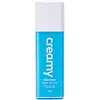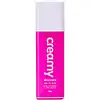What's inside
What's inside
 Key Ingredients
Key Ingredients

 Benefits
Benefits

 Concerns
Concerns

 Ingredients Side-by-side
Ingredients Side-by-side

Water
Skin ConditioningGlycolic Acid
BufferingStearic Acid
CleansingCaprylic/Capric Triglyceride
MaskingBis-Diglyceryl Polyacyladipate-2
EmollientGlycerin
HumectantSodium Benzoate
MaskingCetyl Alcohol
EmollientPrunus Amygdalus Dulcis Oil
Skin ConditioningPolysorbate 60
EmulsifyingAmmonium Hydroxide
BufferingCyclopentasiloxane
EmollientBisabolol
MaskingXanthan Gum
EmulsifyingPhenoxyethanol
PreservativeCetearyl Alcohol
EmollientEthylhexylglycerin
Skin ConditioningDisodium EDTA
Water, Glycolic Acid, Stearic Acid, Caprylic/Capric Triglyceride, Bis-Diglyceryl Polyacyladipate-2, Glycerin, Sodium Benzoate, Cetyl Alcohol, Prunus Amygdalus Dulcis Oil, Polysorbate 60, Ammonium Hydroxide, Cyclopentasiloxane, Bisabolol, Xanthan Gum, Phenoxyethanol, Cetearyl Alcohol, Ethylhexylglycerin, Disodium EDTA
 Reviews
Reviews

Ingredients Explained
These ingredients are found in both products.
Ingredients higher up in an ingredient list are typically present in a larger amount.
We don't have a description for Ammonium Hydroxide yet.
Disodium EDTA plays a role in making products more stable by aiding other preservatives.
It is a chelating agent, meaning it neutralizes metal ions that may be found in a product.
Disodium EDTA is a salt of edetic acid and is found to be safe in cosmetic ingredients.
Learn more about Disodium EDTASodium Benzoate is a preservative. It's used in both cosmetic and food products to inhibit the growth of mold and bacteria. It is typically produced synthetically.
Both the US FDA and EU Health Committee have approved the use of sodium benzoate. In the US, levels of 0.1% (of the total product) are allowed.
Sodium benzoate works as a preservative by inhibiting the growth of bacteria inside of cells. It prevents the cell from fermenting a type of sugar using an enzyme called phosphofructokinase.
It is the salt of benzoic acid. Foods containing sodium benzoate include soda, salad dressings, condiments, fruit juices, wines, and snack foods.
Studies for using ascorbic acid and sodium benzoate in cosmetics are lacking, especially in skincare routines with multiple steps.
We always recommend speaking with a professional, such as a dermatologist, if you have any concerns.
Learn more about Sodium BenzoateWater. It's the most common cosmetic ingredient of all. You'll usually see it at the top of ingredient lists, meaning that it makes up the largest part of the product.
So why is it so popular? Water most often acts as a solvent - this means that it helps dissolve other ingredients into the formulation.
You'll also recognize water as that liquid we all need to stay alive. If you see this, drink a glass of water. Stay hydrated!
Learn more about Water